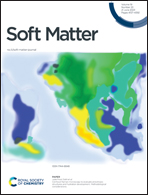Luminescent and self-healing hybrid ionotropic hydrogel beads of ammonium metavanadate and chitosan: promising biomaterial as an antimicrobial agent, efficient dye adsorbent and ascorbic acid sensor†
Abstract
Biopolymers have received widespread attention due to their beneficial characteristics, such as like easy processing, biodegradability and biocompatibility. Concurrently, inorganic polyoxometalates (POMs), a class of metal–oxygen anionic and nanosized clusters of early transition metals, have a wide range of attractive functions and are used in biomedical and industrial fields. In this communication, we report a simple approach to create ammonium metavanadate (AMV)–biopolymer composite hydrogel beads that combine the advantages of biopolymers and POM clusters. Crosslinking was achieved through electrostatic interactions between cationic chitosan, chitosan/gelatin, chitosan/methylcellulose and AMV (NH4VO3). The as-prepared hydrogel beads were yellow in colour and exhibited a high mechanical strength. They were characterized using FT-IR spectroscopy and SEM, to confirm hydrogel formation and evaluate their surface morphology. It was demonstrated that the fabricated hydrogel blend possessed tuneable physicochemical properties, good swelling behaviour (with a maximum swelling of 432%), excellent luminescence and adsorption, and remarkable biomedical properties. Batch adsorption experiments demonstrated that the beads had an equilibrium adsorption capacity of 539 mg g−1 for the removal of Congo red dye from aqueous solutions, which was more efficient than the most reported natural biosorbents. Due to their luminescence properties these hydrogel beads showed excellent selective sensing behaviour toward ascorbic acid with a LOD of 1.06 μM. The hydrogels were also assessed for their antibacterial activity, and were tested against Staphylococcus aureus, Escherichia coli, Streptococcus anginosus, and Klebsiella pneumoniae. The cytotoxicity results showed that the embedded POMs exhibited dose-dependent cytotoxicity against the embryonic kidney cell line (HEK).



 Please wait while we load your content...
Please wait while we load your content...